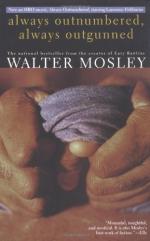|
This section contains 1,408 words (approx. 5 pages at 300 words per page) |

|
SOURCE: Curwen, Thomas. “Black and Blue.” Los Angeles Times Book Review (9 November 1997): 9.
In the following review, Curwen observes that the unifying themes of the short stories in Always Outnumbered, Always Outgunned are how the concept of invisibility and blues music relate to the modern African American experience.
Fats Waller had just gotten out of jail in 1929 for alimony arrears when he penned the haunting melody to “(What Did I Do To Be So) Black and Blue,” and Louis Armstrong sang his version of the song so painfully that Ralph Ellison heard it in 1947 when he wrote Invisible Man. Fifty years later, invisibility and the blues still ravage and bless the African American landscape: no less in Los Angeles, no less in Walter Mosley's unflinching portraits of this city.
His latest, Always Outnumbered, Always Outgunned, leaves behind Easy Rawlins and the Watts of the late '40s, '50s...
|
This section contains 1,408 words (approx. 5 pages at 300 words per page) |

|


